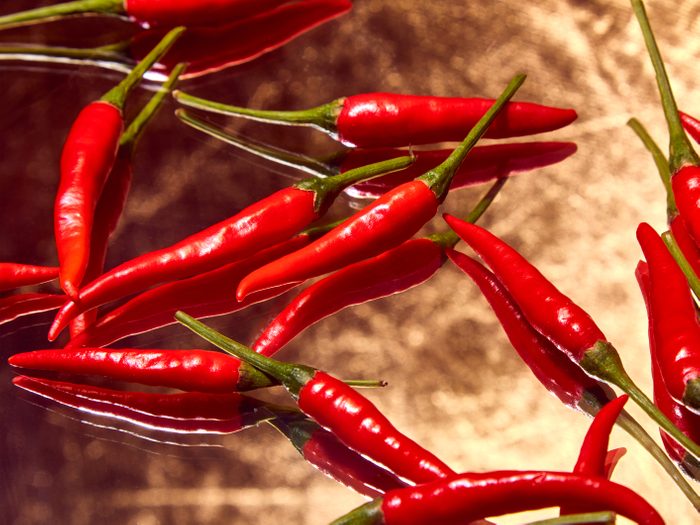The Health Benefits of Spicy Food, Explained

Hot peppers bring the heat, and the health benefits, to the table.
Call it benign masochism, or a cheap thrill, but the appeal of hot peppers is that they hurt so good. If you love the burn, you’ll also love the benefits that hot peppers can have on inflammation, pain and metabolism.
Capsaicin, the chemical in peppers’ seeds that gives them their heat, is what makes some peppers fiery and others plain. Most species of pepper contain capsaicin, except for bell peppers, which is why they aren’t spicy. That burning feeling from capsaicin is courtesy of the body’s pain response system, a safety mechanism that alerts you when you’ve touched something too hot, cold or sharp. Capsaicin activates a protein in your body’s cells called TRPV1, whose job is to sense heat and inflammation. When TRPV1 senses a stressor, it sends a signal to the brain, which sends a jolt of pain back to the affected part of the body. Although the brain chemistry is the same, biting into a jalapeño doesn’t damage the body the way touching a hot stovetop will, at least not in small amounts, and can even relieve pain.
Exposure to capsaicin in large quantities can make neurons less sensitive to TRPV1. Thanks to this effect, capsaicin is frequently used as the active ingredient in skin patches, gels and creams that are effective at reducing feelings of acute and chronic pain from nerve damage, osteoarthritis, rheumatoid arthritis and skin conditions such as psoriasis.
Capsaicin has restorative effects internally too. The activation of TRPV1 stimulates antioxidant activity and reduces inflammation by inhibiting the release of inflammatory proteins known as cytokines in the body, which, if not treated, can eventually lead to the development of conditions like cardiovascular disease and diabetes.
Once in the body, the mighty chemical increases nutrients’ ability to move through the intestinal wall, enhancing the absorption of minerals like calcium, iron and zinc. Capsaicin also has metabolism-boosting potential. It’s shown to have similar effects on energy expenditure as cold temperatures, leading to a short-term spike in body temperature that increases the number of calories burned.
Hot peppers can be grouped into different categories depending on their flavour and heat. Mild peppers with a vegetal taste closer to a bell pepper include poblano and Anaheim varieties. These larger peppers are ideal for stuffing with cheese and meat, or for grilling and roasting. Jalapeños and serranos are smaller and moderately spicy, with a bright, citrusy taste. They work well in salsas, guacamole, dressings and chili. On the hotter end of the spectrum are Thai bird’s eye chilies, tiny red peppers that pack a big punch and work nicely thinly sliced and used as a garnish for stir fries and roasted vegetables. Not for the faint of heart are small, round Scotch bonnet and habanero peppers that hail from the Caribbean. These peppers have a fruity flavour and plenty of heat and are best used sparingly in marinades, like jerk sauce, or in a sweet fruit-based salsa.
Most varieties start off green, but they can turn all different shades as they mature. Rest assured, they are the same pepper, but the yellow, orange and red chilies that have been left to ripen on the vine longer will have more natural sugars and taste spicier. Whatever the variety (or colour), pick out peppers that are bright, have smooth, taut skin and are firm to the touch. And take precautions while handling peppers: Wear gloves—your eyes will thank you later!
Can’t take the heat? Remove the seeds and inner white membrane of the peppers, which is where the capsaicin hides out. Or fight heat with heat by grilling, sauteing or roasting peppers, which caramelizes sugars and leads to a deeper, sweeter taste. Pickling preserves the peppers’ flavour and crunch while taming the spice. Serve pickled peppers with cheese and a drizzle of honey for a sweet heat, or add them to salads and sandwiches for a hot and briny hit. If you love spicy margaritas, try mixing sliced hot peppers into a simple syrup made with equal parts sugar and water to add a quick kick to cocktails.
Peppers’ power is that they can improve health from both the inside and out. So whether it’s a melt-your-face-off habanero salsa or a slightly more therapeutic approach, they’re sure to bring the heat.
Next: This Spicy Corn Salad Needs to Be Made Before Summer Ends




